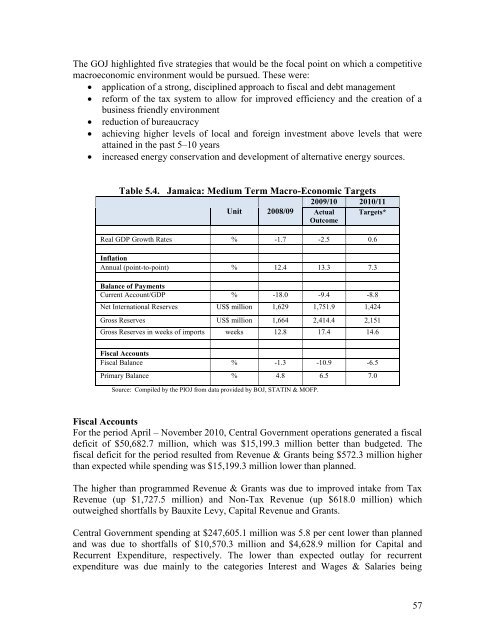PIOJ Growth-Inducement Strategy - Planning Institute of Jamaica
PIOJ Growth-Inducement Strategy - Planning Institute of Jamaica
PIOJ Growth-Inducement Strategy - Planning Institute of Jamaica
You also want an ePaper? Increase the reach of your titles
YUMPU automatically turns print PDFs into web optimized ePapers that Google loves.
The GOJ highlighted five strategies that would be the focal point on which a competitive<br />
macroeconomic environment would be pursued. These were:<br />
application <strong>of</strong> a strong, disciplined approach to fiscal and debt management<br />
reform <strong>of</strong> the tax system to allow for improved efficiency and the creation <strong>of</strong> a<br />
business friendly environment<br />
reduction <strong>of</strong> bureaucracy<br />
achieving higher levels <strong>of</strong> local and foreign investment above levels that were<br />
attained in the past 5–10 years<br />
increased energy conservation and development <strong>of</strong> alternative energy sources.<br />
Table 5.4. <strong>Jamaica</strong>: Medium Term Macro-Economic Targets<br />
Unit 2008/09<br />
2009/10 2010/11<br />
Actual Targets*<br />
Outcome<br />
Real GDP <strong>Growth</strong> Rates % -1.7 -2.5 0.6<br />
Inflation<br />
Annual (point-to-point) % 12.4 13.3 7.3<br />
Balance <strong>of</strong> Payments<br />
Current Account/GDP % -18.0 -9.4 -8.8<br />
Net International Reserves US$ million 1,629 1,751.9 1,424<br />
Gross Reserves US$ million 1,664 2,414.4 2,151<br />
Gross Reserves in weeks <strong>of</strong> imports weeks 12.8 17.4 14.6<br />
Fiscal Accounts<br />
Fiscal Balance % -1.3 -10.9 -6.5<br />
Primary Balance % 4.8 6.5 7.0<br />
Source: Compiled by the <strong>PIOJ</strong> from data provided by BOJ, STATIN & MOFP.<br />
Fiscal Accounts<br />
For the period April – November 2010, Central Government operations generated a fiscal<br />
deficit <strong>of</strong> $50,682.7 million, which was $15,199.3 million better than budgeted. The<br />
fiscal deficit for the period resulted from Revenue & Grants being $572.3 million higher<br />
than expected while spending was $15,199.3 million lower than planned.<br />
The higher than programmed Revenue & Grants was due to improved intake from Tax<br />
Revenue (up $1,727.5 million) and Non-Tax Revenue (up $618.0 million) which<br />
outweighed shortfalls by Bauxite Levy, Capital Revenue and Grants.<br />
Central Government spending at $247,605.1 million was 5.8 per cent lower than planned<br />
and was due to shortfalls <strong>of</strong> $10,570.3 million and $4,628.9 million for Capital and<br />
Recurrent Expenditure, respectively. The lower than expected outlay for recurrent<br />
expenditure was due mainly to the categories Interest and Wages & Salaries being<br />
57
















